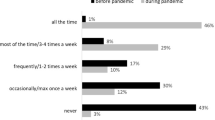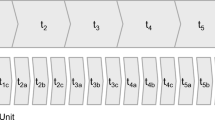Abstract
Digital communication technologies allow organizational members to work independent from time and space (cf. Khan and Agha, 14(4):103–114, 2013: 16). Using this new freedom carefully is advisable, since new expectations on availability may develop interactively (cf. Entschew and Suchanek, 2017: 312; Sydow et al., 2009: 700). The potential development of a self-reinforcing impulse of accelerated communication and an implicit availability demand may lead to a new organizational norm of permanent availability (cf. Entschew and Suchanek, 2017: 312–313; Menz, 2017: 22). This issue became more relevant than ever due to the Covid-19 pandemic. As a result, more and more people work from home using digital communication technologies. For some organizational members, compliance with such demands implies inter-role conflicts since it collides with other commitments (e.g., family responsibilities, community work, recreation, hobbies and leisure). Inter-role conflicts (organizational role vs. family role vs. community role vs. recreational role etc.) occur if there are role expectations placed upon a human such that compliance with one role makes compliance with the other role difficult (cf. Katz and Kahn, 1978/1966: 204). A problem occurs if an organization becomes greedy and (implicitly) requests undivided commitment of its organizational members (cf. Coser, 1974: 4–7). Powerful leaders may drive this: ‘[…] if the leader gets greedy, demanding the same level of urgency every day, the energy will fizzle and performance will sink, despite employees’ heroics’ (Bruch and Menges, 2010: 6). Organizational members potentially become hyperincluded. Hyperinclusion describes the main determination of one’s life through one institution demanding (excessive) role expectations (cf. Erfurt Sandhu, 2014: 176, 188). Accordingly, all other roles of one’s life comply with these (work) demands (e.g., one’s residence, selection of friends, leisure activities). Due to the (potential) development of such scenario, the recommendation of this paper is to institutionalize training on digital literacy as well as on moral discernment in organizations. Training managers and employees to responsibly deal with new freedom through digital communication allows sustainably making use of the advantages, which these technologies offer.
Access this chapter
Tax calculation will be finalised at checkout
Purchases are for personal use only
Similar content being viewed by others
Notes
- 1.
The term ‘organizational members’ refers to staff at the non-managerial level (here: employees) as well as staff at the managerial level (here: executives, superiors, leaders, etc.).
- 2.
- 3.
In the study of Strobel (2013: 18), some organizational members appreciate to get fast support: ‘As an employee it is very comfortable if the executive is always on; it is like a hotline were you always get information’.
- 4.
For some professional groups it is relevant for their organizational role’s identity to be permanently available (Strobel 2013: 18).
- 5.
It can be assumed that the consequences vary for different personalities as well as generations.
References
Al-Saggaf, Y., O. Burmeister, and J. Weckert. 2015. Reasons behind Unethical Behaviour in the Australian ICT Workplace: An Empirical Investigation. Journal of Information, Communication and Ethics in Society 13(3/4):235–255.
Augier, M., and L. Mola. 2016. Reshaping Organizations with Social Networks and Collaboration. In Blurring the Boundaries through Digital Innovation. Individual, Organizational, and Societal Challenges, ed. F. D’Ascenzo, M. Magni, A. Lazazzara, and S. Za, 9–20. Basel: Springer.
Badaracco, J.L. 2016a. How to Tackle Your Toughest Decisions. Harvard Business Review 94(9):104–107.
Badaracco, J.L. 2016b. Timeless Advice for Making a Hard Choice. Harvard Business Review, 94.
Baumeister, R.F., and B.J. Bushman. 2014. Social Psychology and Human Nature, 3rd ed. Bel-mont: Wadsworth Cengage Learning.
Bette, K.-H., and U. Schimank. 2006. Die Dopingfalle: Soziologische Betrachtungen. Bielefeld: Transcript.
Bicchieri, C., and E. Xiao. 2009. Do the Right Thing: But Only if Others do so. Journal of Behavioral Decision Making 22(2):191–208.
Boeldicke, E.M., and P. Erfurt Sandhu. 2017. Staendig erreichbar: Die Entgrenzung von Mensch und Organisation. Zeitschrift Für Unternehmensentwicklung Und Change Management 36(4):56–59.
Boewe, J., and J. Schulten. 2014. Dienstplanung per Smartphone: Mobile Anwendungen zur Personaleinsatzplanung fordern Betriebsräte heraus. Magazin Mitbestimmung, Hans-Böckler-Stiftung 12:16–19.
Boswell, W.R., and J.B. Olson-Buchanan. 2016. The Use of Communication Technologies after Hours: The Role of Work Attitudes and Work-Life Conflict. Journal of Management 33(4):592–610.
Bruch, H., and J.I. Menges. 2010. The Acceleration Trap. Harvard Business Review 88(4):80–86.
Burmeister, O.K. 2017. Professional Ethics in the Information Age. Journal of Information, Communication and Ethics in Society 15(4):348–356.
Coser, L.A. 1974. Greedy Institutions: Patterns of Undivided Commitment. New York: The Free Press.
Derks, D., L.L. ten Brummelhuis, D. Zecic, and A.B. Bakker. 2012. Switching on and off …: Does Smartphone use Obstruct the Possibility to Engage in Recovery Activities? European Journal of Work and Organizational Psychology 23(1):80–90.
Derks, D., H. van Mierlo, and E.B. Schmitz. 2014. A Diary Study on Work-Related Smartphone Use, Psychological Detachment and Exhaustion: Examining the Role of the Perceived Segmentation Norm. Journal of Occupational Health Psychology 19(1):74–84.
Dettmers, J., and E. Bamberg. 2014. Rufbereitschaft als erweiterte Verfügbarkeit für die Erwerbsarbeit. In Rufbereitschaft: Wenn die Ar-beit in der Freizeit ruft, 1st ed., ed. S. Fietze, M. Keller, N. Friedrich, and J. Dettmers, 151–174. München: Hampp.
Edwards, D. 2011. I’m Feeling Lucky: The Confessions of Google Employee Number 59. New York: Houghton Mifflin Harcourt Publishing Company.
Egger de Campo, M. 2013. Contemporary Greedy Institutions: An Essay on Lewis Coser’s Concept in the Era of the ‘Hive Mind.’ Czech Sociological Review 49(6):969–987.
Egger de Campo, M. 2014. Neue Medien – Alte Greedy Institutions. Leviathan 42(1):7–28.
Entschew, E.M., and A. Suchanek. 2017. Digital Communication: A New Challenge for Moral Discernment. Journal for Business, Economics and Ethics 18(3):305–327.
Erfurt Sandhu, P. 2013. Persistent Homogeneity in Top Management: Organizational Path Dependence in Leadership Selection. Berlin: Freie Universität, Diss.
Erfurt Sandhu, P. 2014. “Er muss diesen Beruf gerne machen, mit Leib und Seele.”: Hyperinklusion als Erfolgskriterium für oberste Führungskräfte in einem internationalen Beratungsutnernehmen. Leviathan 42(Sonderband 29):176–193.
Fenner, G.H., and R.W. Renn. 2004. Technology-assisted Supplemental Work: Construct Definition and a Research Framework. Human Resource Management 43(2–3):179–200.
Goebel, M., and J.F.K. Schmidt. 1998. Inklusion/Exklusion: Karriere, Probleme und Differenzierungen eines systemtheoretischen Begriffspaars. Soziale Systeme – Zeitschrift Für Soziologi-Sche Theorie 4(1):87–117.
Groß, C. 2008. Multi-Level-Marketing: Identität und Ideologie im Network-Marketing, 1st ed. Wiesbaden: VS Verlag.
Hamilton, K., K. Karahalios, C. Sandvig, and M. Eslami. 2014. A Path to Understanding the Effects of Algorithm Awareness. In CHI ’14 Extended Abstracts on Human Factors in Computing Systems, ed. M. Jones, P. Palanque, A. Schmidt, and T. Grossman, 631–642. New York: ACM.
Hampton, K.N. 2016. Persistent and Pervasive Community: New Communication Technologies and the Future of Community. American Behavioral Scientist 60(1):101–124.
Hassler, M., and R. Rau. 2016. Ständige Erreichbarkeit: Flexibilisierungsanforderung oder Flexibilisierungsmöglichkeit? Wirtschaftspsychologie 18(2):25–34.
Hassler, M., R. Rau, J. Hupfeld, and H. Paridon. 2016. Auswirkungen von ständiger Erreichbar keit und Präventionsmöglichkeiten: Teil 2: Eine wissenschaftliche Untersuchung zu potentiellen Folgen für Erholung und Gesundheit und Gestaltungsvorschläge für Unternehmen. Dresden: Initiative Gesundheit und Arbeit (iga).
Hughes, R.K. 2006. Disciplines of a Godly Man, 10th ed. Wheaton: Crossway Books.
Hyman, J., and C. Baldry 2011. The Pressures of Commitment: Taking Software Home. In Creating Balance? International Perspectives on the Work-Life Integration of Professionals, ed. S. Kaiser, M.J. Ringlstetter, D.R. Eikhof, and M. Pina e Cunha, 253–268. Berlin: Springer.
Kant, I. 2002. Groundwork for the Metaphysics of Morals. New Haven: Yale University Press.
Katz, D., and R.L. Kahn. 1978. The Social Psychology of Organizations, 2nd ed. New York: Wiley.
Khan, S.A., and K. Agha. 2013. Dynamics of the Work Life Balance at the Firm Level: Issues and Challenges. Journal of Management Policy and Practice 14(4):103–114.
Koehn, D. 2001. Ethical Issues Connected with Multi-Level Marketing Schemes. Journal of Business Ethics 29(1/2):153–160.
Litschka, M., and M. Karmasin. 2012. Ethical Implications of the Mediatization of Organizations. Journal of Information, Communication and Ethics in Society 10(4):222–239.
Luhmann, N. 1989. Ecological Communication. Chicago: University of Chicago Press.
Luhmann, N. 1995. Social Systems. Stanford: Stanford University Press.
Menz, W. 2017. Erweiterte arbeitsbezogene Erreichbarkeit Ausprägungen, Belastungen, Handlungsstrategien: Ergebnisse einer qualitativen Beschäftigtenbefragung des Projekts MASTER – Management ständiger Erreichbarkeit. München: ISF München.
Middleton, C.A., and W. Cukier. 2006. Is Mobile Email Functional or Dysfunctional? Two Perspectives on Mobile Email Usage. European Journal of Information Systems 15(3):252–260.
PwC. 2014. Health Wearables: Early Days. New York: PricewaterhouseCoopers.
Richter, P., E. Rotheiler, and M. Rudolf. 2015. FABA – Fragebogen zur Analyse belastungsrele- vanter Anforderungsbewältigung, 2nd ed. Großhöflein: P&T Prieler Tometich Verlag.
Rosa, H. 2014. Beschleunigung: Die Veränderung der Zeitstrukturen in der Moderne, 10th ed. Frankfurt a. M.: Suhrkamp.
Schaarschmidt, U., and A. Fischer. 1997. AVEM – Ein diagnostisches Instrument zur Differenzierung von Typen gesundheitsrelevanten Verhaltens und Erlebens gegenüber der Arbeit. Zeitschrift Für Differentielle Und Diagnostische Psychologie/journal of Individual Differences 18(3):151–163.
Sennett, R. 2012. Together: The Rituals, Pleasures and Politics of Cooperation. New Haven: Yale University Press.
Sonnentag, S. 2003. Recovery, Work Engagement, and Proactive Behavior: A New Look at the Interface between Nonwork and Work. Journal of Applied Psychology 88(3):518–528.
Sonnentag, S., and U.-V. Bayer. 2005. Switching Off Mentally: Predictors and Consequences of Psychological Detachment from Work During Off-Job Time. Journal of Occupational Health Psychology 10(4):393–414.
Sonnentag, S., and U. Kruel. 2006. Psychological Detachment from Work During Off-Job Time: The Role of Job Stressors, Job Involvement, and Recovery-related Self-efficacy. European Journal of Work and Organizational Psychology 15(2):197–217.
Strobel, H. 2013. Auswirkungen von ständiger Erreichbarkeit und Präventionsmöglichkeiten: Teil 1: Überblick über den Stand der Wissenschaft und Empfehlungen für einen guten Umgang in der Praxis. Dresden: Initiative Gesundheit und Arbeit (iga).
Suchanek, A. 2015. Unternehmensethik. In Vertrauen investieren. Tübingen: Mohr Siebeck.
Sullivan, T.A. 2014. Greedy Institutions, Overwork, and Work-Life Balance. Sociological Inquiry 84(1):1–15.
Sydow, J., G. Schreyögg, and J. Koch. 2009. Organizational Path Dependence: Opening the Black Box. Academy of Management Review 34(4):689–709.
Tapscott, D. 2014. The Digital Economy: Rethinking Promise and Peril in the Age of Networked Intelligence, 20th ed. New York: McGraw-Hill.
Wallace, S.E. 1975. Greedy Institutions: Patterns of Undivided Commitment. By Lewis a. Coser. Social Forces 54(2):479–480.
Author information
Authors and Affiliations
Corresponding author
Editor information
Editors and Affiliations
Rights and permissions
Copyright information
© 2022 The Author(s), under exclusive license to Springer-Verlag GmbH, DE, part of Springer Nature
About this chapter
Cite this chapter
Entschew, E.M. (2022). Digital Communication in and Beyond Organizations—A Path to Hyperinclusion. In: Lütge, C., Uhl, M., Kriebitz, A., Max, R. (eds) Business Ethics and Digitization. Wirtschaftsethik in der globalisierten Welt. J.B. Metzler, Berlin, Heidelberg. https://doi.org/10.1007/978-3-662-64094-4_4
Download citation
DOI: https://doi.org/10.1007/978-3-662-64094-4_4
Published:
Publisher Name: J.B. Metzler, Berlin, Heidelberg
Print ISBN: 978-3-662-64093-7
Online ISBN: 978-3-662-64094-4
eBook Packages: J.B. Metzler Humanities (German Language)




